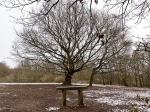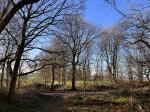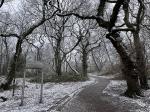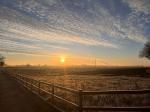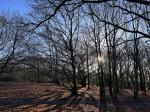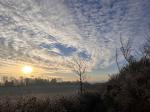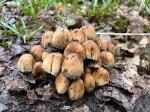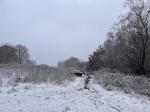Brayton Barff Through the Seasons.
Set in the Vale of York, South West of the market town of Selby and between the villages of Thorpe Willoughby and Brayton, lies Brayton Barff, a sandstone Hill approximately one hundred and fifty feet in height which was formed by glacial movement during the last Ice Age. It is a significant landmark in an otherwise flat landscape.
Today the site is primarily owned by Yorkshire Water with Selby District Council owning a small patch of the land adjacent to the A63 Selby bypass. A large underground reservoir occupies the centre of the site which delivers water to around 4.7 million customers throughout Yorkshire.
Within the Barff woodland over 40% of the trees are Sessile Oak which are generally found in semi natural woodlands in the north of the country. These trees are so called because its acorns are not held on stalks, like those of the English Oak (Pedunculate), but attached directly to the outer twigs. There are also several English Oak trees as well as some cross-hybrid oaks. These trees are known to support many species of flora and fauna, invertebrates, mosses, lichen and fungi.
During the Victorian times it is thought that the shipbuilders on the east coast would come over to the Barff for selected cuts of timber to build their sea going vessels.
The Barff also has a variety of other trees including Silver Birch, Beech, Sycamore, Holly, Rowan, Scots Pine, Alder, Hawthorne and European Larch. There are also several Yew, Willow, Hazel, Horse Chestnut and Wych Elm. As with similar woodlands there are a variety of bushes, including Honeysuckle, Elderberry, Gorse, Broom and Buddleia.
The history of Brayton Barff is quite vague, apparently during 1803 a beacon was lit on the Barff when the country was threatened with an invasion by Napoleon. In May 1935, to celebrate King George V's Silver Jubilee, a Bonfire was lit on the Barff as part of the celebrations.
Early issues of Ordnance Survey Maps dated 1903 clearly show a rifle range on the Barff, extending out to Mill Lane. During the 
Between 2001 – 2004 the A63 Selby bypass, 10km twin lane single carriageway was constructed which severed the South West corner of the Barff, adjacent to Selby Golf Course and resulted in a slight redesign of several holes on the golf course. Wooden fencing was erected as a result of this new road running alongside of the Barff and a footbridge constructed over the ‘new road’ following the line of the Bridal way which extends from Mill Lane. Around 2005/2006 a definite 2metre wide limestone aggregate footpath was laid forming a circular path around the outer edges of the woodland. This footpath is approximately 1.2 miles in length and takes about 30 minutes to circumnavigate at a leisurely pace.
In 2012 the Barff was declared an Ancient Oak Woodland and as such throughout 2012 and 2013 significant work had been carried out by the relevant agencies to cut and remove large swathes of non-native trees, creating at that time huge scars on the landscape. Some three years later the planting of the native trees have become well established and are flourishing. Ongoing maintenance work on the footpath around the bottom of the Barff was completed during the Summer of 2016.
A second phase of woodland maintenance commenced during the Autumn of 2019 with the removal of many old and diseased trees and the cutting back of the Gorse and Broom bushes, especially adjacent to the ‘bypass trail’, this work continued through till March 2020 with re planting continuing into April 2020.
Brayton Barff is a popular site for walkers and bird watchers alike and a path circling the outer perimeter of the Barff makes a pleasant thirty minute walk, giving views looking over towards Selby and the village of Brayton as well as the power stations of Drax and Eggborough..jpg)
For the early risers it is a great place to see some stunning sunrises over the villages of Brayton looking towards Drax Power Station, the same with the Sunsets looking over towards Eggborough and Monk Fryston.
The Barff changes with the Seasons and every visit can reveal something new, the woodland is a haven for wildlife. Records show that since 1982 one hundred and twelve species of bird have been seen in the woodland and at least 40 of those have bred here, including Tawny Owl, Buzzard, Green Woodpecker, Spotted Flycatcher, Goldcrest and Nuthatch to name just a few. On average over 70 species of bird are recorded each year. Further details of the bird life on the Barff can be found on the Brayton Barff Group Facebook page, especially the posts from Derek Cooper. Today ‘The Friends of Brayton Barff group’ led by Derek and a small team of volunteers help keep and maintain the cleanliness of the site as well as recording the wildlife and bird sightings.
The Barff is also home to fifteen different species of mammals, including Muntjac Deer, Pipistrelle Bat, Fox, and Field Vole.
Over eighty species of plant and wildflowers have been recorded, included Bee Orchid, Northern Marsh Orchid, Wood Anemone, Marsh Ragwort, Bluebell, White Bluebell, Bittersweet and Purple and White Foxgloves. Over twenty species of Butterfly have been recorded, including Marbled White, Brown Angus, Speckled Wood, Comma and Brimstone.
During the Autumnal months fungi thrives in this woodland environment, species including Fly Agaric, Beefsteak Tree Fungi, Chicken of the Wood, Sulphur Tufts, Stinkhorn, Ink cap, Puffballs and Hoof Bracket are just some of the many varieties that can be found here.
Click on the galleries shown below to expand the albums.
March 2023
Well, here we are at the end of what has been a very wet month here in North Yorkshire, the stats for March state that it was the wettest month since 1981. Rainfall was well above average in most areas of the country with over twice the average amount for many southern areas, and only north-western Scotland was drier than average. The Country had 155% of average rainfall for the month, and it was the sixth wettest March since records back in 1836. What was surprising was that it was a sunnier than average month for the western side of Scotland, but rather dull for most other parts of the country, with some places having barely half their average sunshine. Overall, it was the dullest March since 1910.
Daily temperatures for this month ended close to the average for this time of year at around 5.7C
We had several Yellow Weather Warnings issued by the Met office, for ice and snow, and several mornings were the temperature dropped just below freezing to give an overnight frost. During the early hours of Thursday 9th we woke up to a light dusting of snow which had all but disappeared by mid-morning. That evening it started to rain and during the early hours of Friday 10th the temperature fell to -2c. We woke up on Friday morning to 1” of snow. Embarrassingly this caused our two Secondary schools in the area to close for the day! By the following morning (Saturday) all the snow had melted and we woke up to a cold and frosty morning. I might add that the Yorkshire Dales and parts of the North Yorkshire moors had some significant snowfall with roads closed for several days and powerlines compromised, so we were very fortunate in this part of the county to escape the harshest of the weather.
Spring has arrived in earnest on the Barff, all the trees are in bud, The Gorse bushes are covered in lovely tiny yellow florets, Blackthorn bushes are in full bloom covered in blossom so it should be a good year for Sloe berries by the amount of blossom. Huge clusters of Celandine are growing and spreading quite wildly around the woodland floor, within the next week or so their little yellow florets should be flowering. Lichen and mosses seem to have taken a good hold on many of our rotting tree stumps and branches, shoots of wild garlic are springing through the leaf litter at an alarming rate, Creeping Buttercup are growing and will be coming into flower shortly, I have noticed along the Bypass trail a couple of patches of Sweet Violets in flower, their tiny purple/blue florets keeping close to the ground. The Bluebells are also beginning to come into flower, the first ones started to flower around the middle of the month, though by the end of March many more are now in flower, the early ones benefiting from the early morning sunlight, it will be mid-April before they all come into flower and the eastern side of the woodland will be covered in a huge blue blanket. The Foxgloves are coming to life after being quite dormant over the winter months, I have spotted several about six inches tall recently. Wood Sorrel is coming into flower all over the Barff, its tiny white florets although still closed early in the morning are opening up once the temperature warms up during the day. Dandelions have shot up this month and are even flowering, Nettles too are shooting up all around the woodland, especially alongside of the main perimeter footpath as well as deep into the woodland under the canopy of the trees. It is nice to see clusters of Daffodils around the woodland in full flower, their colour brightening up even the dullest of mornings.
It interesting to see that fungi continues to thrive in the Barff woodland, even at this time of year, I have noticed several clumps of Sulphur tufts, shooting out of some rotten Birch trees recently and I have heard of several sightings of Candlesnuff, Yellow Brain Fungi & Scarlet Elf Cup around the woodland, though I have not yet seen them.
The Buzzard continues to be very active around the woodland, as are the Kestrel and Tawny Owls. The Chiffchaff have returned from their winter vocation in Africa to the Barff this month, their numbers seem to be increasing on a daily basis. It is nice to hear the Mistle Thrush has returned to the Barff. Our resident Robins, Chaffinch, Great & Blue Tits, Goldcrest and Redwings can be seen and heard most days. Male and female Pheasants can be seen most days too, Meg & Gracie occasionally send them scooting off into the distance, alarm calling as they go. Treecreepers are quite visible at the moment, their white breast catches my attention as they scurry up the tree trunks, stopping every now and then to prize a grub from under the tree bark with their short, curved beak. The Nuthatch’s has been very quiet, I haven’t heard them for several weeks now, I’m hoping they are sat on eggs in which case they will be quiet, once the weather settles down a little they may become more vocal again.
I had a look at our solitary Wych Elm tree the other day, sadly, just before Autumn last year it started to lose it leaves, a little sooner than usual, it should be in bud by now, but many of branches were dead and dried out, which is such a shame. I wonder if it has succumbed to the Elm Bark beetle?
Several highlights for me this month have being seeing how the snow completely transforms the woodland, albeit for just a couple of days, secondly, on Wednesday 15th there were some beautiful early morning cloud formations and finally, there is nothing better than a walk around the Barff in glorious sunshine, and although we have had some variable weather this month, the sunshine certainly lifts the spirits. With the Easter holidays just around the corner lets hope we can enjoy some sunnier and warmer weather. Have a good holiday.
|


